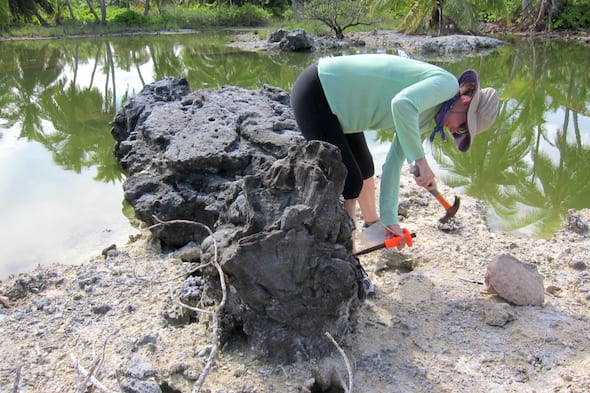Rice, Georgia Tech study in Science reveals Pacific temperatures over a millennium
There is no longer a need to guess what ocean temperatures were like in the remote tropical Pacific hundreds of years ago. The ancient coral that lived there know all.
A study in Science led by Rice University and Georgia Tech researchers parses the record archived by ancient tropical Pacific coral over the past millennium. That record could help scientists refine their models of how changing conditions in the Pacific, particularly from volcanic eruptions, influence the occurrence of El Niño events, which are major drivers of global climate.

Georgia Tech climate scientist Kim Cobb samples an ancient coral for radiometric dating. She is part of a team of Rice University and Georgia Tech scientists using data from coral fossils to build a record of temperatures in the tropical Pacific Ocean over the last millennium. (Credit: Cobb Lab)
They found the ratio of oxygen isotopes sequestered in coral, an accurate measure of historic ocean temperatures, shows no correlation between estimates of sulfate particles ejected into the atmosphere by tropical volcanic eruptions and El Niño events.
That result could be of particular interest to scientists who suggest seeding the atmosphere with sun-blocking particles may help reverse global warming.
According to Rice climate scientist and primary author Sylvia Dee, previous climate model studies often tie volcanic eruptions, which increase sulfate aerosols in the atmosphere, to increased chances for an El Niño event. But the ability to analyze climate conditions based on oxygen isotopes trapped in fossil corals extends the climatological record in this key region across more than 20 ancient eruptions. Dee said this allows for a more rigorous test of the connection.
“A lot of climate modeling studies show a dynamical connection where volcanic eruptions can initiate El Niño events,” Dee said. “We can run climate models many centuries into the past, simulating volcanic eruptions for the last millennium.

Sylvia Dee
“But the models are just that — models — and the coral record captures reality.”
Coral data that Georgia Tech climate scientist Kim Cobb and her team arduously collected on trips to the Pacific show little connection between known volcanoes and El Niño events over that time. Like tree rings, these paleoclimate archives hold chemical indicators, the oxygen isotopes, of oceanic conditions at the time they formed.
The coral data yields a high-fidelity record with a resolution of less than a month, tracking the El Niño-Southern Oscillation (ENSO) in the heart of the central tropical Pacific.
The eight time-overlapped corals Cobb and her colleagues recently studied held an unambiguous record of conditions over 319 years, from 1146-1465. This and data from other corals spans more than 500 years of the last millennium and, they wrote, “presents a window into the effects of large volcanic eruptions on tropical Pacific climate.”
That span of time includes the 1257 eruption of Mt. Samalas, the largest and most sulfurous of the last millennium.
Cobb said her lab has been developing techniques and expanding the coral record for years. “My first expedition to the islands was in 1997, and it has been my sole focus pretty much since then to extract the best records that we can from these regions,” she said, noting the lab has issued many papers on the topic, including a groundbreaking 2003 study on ENSO in Nature.
Cobb said dating the ancient coral samples depends on precise uranium-thorium dating, followed by thousands of mass spectrometric analyses of coral oxygen isotopes from powders drilled every 1 millimeter across the coral’s growth axis. “That speaks to the temperature reconstruction,” she said. “We’re borrowing on 70 years of work with this particular chemistry to establish a robust temperature proxy in corals.”

Kim Cobb
The oxygen-16 to oxygen-18 isotopes revealed by spectrometry show the temperature of the water at the time the coral formed, Cobb said. “The ratio of those two isotopes in carbonates is a function of the temperature,” she said. “That’s the magic: It’s based on pure thermodynamics.”
“This beautiful coral record is highly sensitive to El Niño and La Niña events based on its location,” Dee added. “My collaborators worked to extend this coral record to span a period where we know there were a lot of explosive volcanic eruptions, especially in the first half of the millennium.
“Scientists have reconstructed the timing of those volcanic eruptions from ice-core records,” she said. “We compared the timing of the largest eruptions to the coral record to see if volcanic cooling events had any impact on tropical Pacific climate.”
Only some volcanoes launch particulate matter — particularly sulfate particles, leading to a phenomenon called sulfate aerosol forcing — into the stratosphere, where the particles reflect incoming sunlight and cool the planet over the short term, Dee said. “But that cooling’s impact on the tropical Pacific is uncertain, and might be regionally heterogeneous,” she said.
“Our study suggests that linkage (between volcanoes and ENSO) doesn’t exist or, if it does, it is obscured by the large natural variability in the climate system,” Dee said. “In general, El Niño is a natural oscillator in the climate system. It’s a product of chaos, like a Slinky going back and forth. It is so strong that the system might be immune to big climate perturbations like short-term volcanic cooling.
“Incidentally, our scientific community uses the same climate models that we evaluated to estimate the climate’s response to geoengineering and solar radiation management schemes that employ sulfate aerosols,” Dee said.
Cobb and Dee characterized the study as a cautionary tale for those who study geoengineering. “There is no doubt whatsoever that if we inject stratospheric aerosols, we will cool the planet,” Cobb said. “That’s been shown and modelled. What we’re trying to ask is, what else happens? And how well can we predict that? Our work really motivates further study to flesh out the full scope of climate impacts from sulfate aerosols.”
Co-authors of the paper are Julien Emile-Geay, an associate professor of Earth sciences at the University of Southern California; Toby Ault, an associate professor of Earth and atmospheric sciences at Cornell University; Lawrence Edwards, the Regents & Distinguished McKnight University Professor at the University of Minnesota; research scientist Hai Cheng of Minnesota and Xi’an Jiaotong University, China; and Christopher Charles, a professor at the Scripps Institution of Oceanography at the University of California, San Diego.
The research was supported by the National Science Foundation, Brown University and the University of Texas at Austin.

